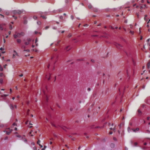Prevalence of Blood Vessel Disease
To test their hypothesis that renal arteriosclerosis would occur at a younger age in patients with lupus nephritis compared with healthy controls, Garg et al. reviewed data on 189 patients with lupus nephritis who underwent native renal biopsy between 1994 and 2017 at the University of Wisconsin Hospital and Clinics. Patients ranged in age from 2–79 years (median age of 25 years), and the majority were female (78%) and white (73%).
Biopsy reports showed that 41% had renal arterial changes (31% had renal arteriosclerosis and 12% had hyaline arteriolosclerosis), and that renal arteriosclerosis increased with age. Overall, one in three patients 60–69 years old had moderate-to-severe sclerosis.
When compared with healthy controls, the onset of any arteriosclerosis in patients with lupus nephritis occurred two decades earlier. Patients with lupus nephritis aged 30–39 years had comparable renal arteriosclerosis to healthy kidney donors aged 50–59 years (41% vs. 44%), and patients with lupus nephritis aged 40–49 years had comparable renal arteriosclerosis to controls 60–69 years (52% vs. 51%). Patients with lupus nephritis aged 60–69 years had a fivefold higher prevalence of moderately severe arteriosclerosis compared with age-matched healthy donors (33% vs. 6%).
The study found age and lupus nephritis chronicity were independent predictors of renal arteriosclerosis. Patients with lupus nephritis who were older than 30 years had threefold higher odds of developing renal arteriosclerosis than patients younger than 30 (odds ratio [OR] 3.3; confidence interval [CI], 1.3, 9.1; P=0.02), and patients with chronic lupus nephritis had a fourfold greater odds (OR 4.0; CI, 1.5, 11.6; P=0.01)
Commenting on these findings, Ram Raj Singh, MD, professor of medicine, rheumatology, and pathology at the David Geffen School of Medicine, University of California, Los Angeles, emphasizes the need for more research to better understand why some patients with lupus nephritis develop renal arteriosclerosis. He also notes the need for additional research given the small numbers in the study and the predominance of white patients.
“Because non-white patients generally have more severe lupus nephritis and poorer outcomes from lupus, future studies involving diverse patient populations would be needed to further realize the importance of this research,” he says.
The authors note the lack of diversity as a study limitation, and according to Dr. Garg, future research will focus on diverse cohorts and the correlation between renal arteriosclerosis and CVD occurrence.
Universal Reporting
By over-reading renal biopsies in a subset of 42 patients using the Banff criteria for grading, the researchers also examined whether the burden of renal arteriosclerosis is under-reported in lupus nephritis biopsies. The Banff grading system categorizes renal arteriosclerosis as none, mild (<25%), moderate (26–50%) and severe (>50%) luminal narrowing. Patients included in this analysis had a mean age of 31 years at the time of their diagnosis of lupus nephritis, most were women (75%), a minority were Black (25%), and nearly half (49%) had chronic lupus nephritis.



